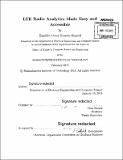| dc.contributor.advisor | Dina Katabi. | en_US |
| dc.contributor.author | Hamed, Ezzeldin Omar Hussein | en_US |
| dc.contributor.other | Massachusetts Institute of Technology. Department of Electrical Engineering and Computer Science. | en_US |
| dc.date.accessioned | 2015-06-10T19:09:55Z | |
| dc.date.available | 2015-06-10T19:09:55Z | |
| dc.date.copyright | 2015 | en_US |
| dc.date.issued | 2015 | en_US |
| dc.identifier.uri | http://hdl.handle.net/1721.1/97326 | |
| dc.description | Thesis: S.M. in Computer Science and Engineering, Massachusetts Institute of Technology, Department of Electrical Engineering and Computer Science, 2015. | en_US |
| dc.description | Cataloged from PDF version of thesis. | en_US |
| dc.description | Includes bibliographical references (pages 69-71). | en_US |
| dc.description.abstract | Despite the rapid growth of next-generation cellular networks, researchers and end users today have limited visibility into the performance and problems of these networks. As LTE deployments move towards femto and pico cells, even operators struggle to fully understand the propagation and interference patterns affecting their service, particularly indoors. This thesis introduces LTEye, the first open platform to monitor and analyze LTE radio performance at a fine temporal and spatial granularity. LTEye accesses the LTE PHY layer without requiring private user information or provider support. It provides deep insights into the PHY-layer protocols deployed in these networks. LTEye's analytics enable researchers and policy makers to uncover serious deficiencies in these networks due to inefficient spectrum utilization and inter-cell interference. In addition, LTEye extends synthetic aperture radar (SAR), widely used for radar and backscatter signals, to operate over cellular signals. This enables businesses and end-users to localize mobile users and capture the distribution of LTE performance across spatial locations in their facility. As a result, they can diagnose problems and better plan deployment of repeaters or femto cells. We implement LTEye on USRP software radios, and present empirical insights and analytics from multiple AT&T and Verizon base stations in our locality. | en_US |
| dc.description.statementofresponsibility | by Ezzeldin Omar Hussein Hamed. | en_US |
| dc.format.extent | 71 pages | en_US |
| dc.language.iso | eng | en_US |
| dc.publisher | Massachusetts Institute of Technology | en_US |
| dc.rights | M.I.T. theses are protected by copyright. They may be viewed from this source for any purpose, but reproduction or distribution in any format is prohibited without written permission. See provided URL for inquiries about permission. | en_US |
| dc.rights.uri | http://dspace.mit.edu/handle/1721.1/7582 | en_US |
| dc.subject | Electrical Engineering and Computer Science. | en_US |
| dc.title | LTE radio analytics made easy and accessible | en_US |
| dc.title.alternative | Long-Term Evolution radio analytics made easy and accessible | en_US |
| dc.type | Thesis | en_US |
| dc.description.degree | S.M. in Computer Science and Engineering | en_US |
| dc.contributor.department | Massachusetts Institute of Technology. Department of Electrical Engineering and Computer Science | |
| dc.identifier.oclc | 910340246 | en_US |
